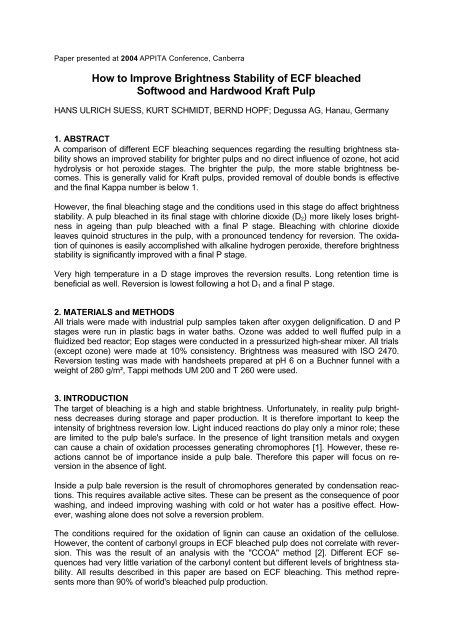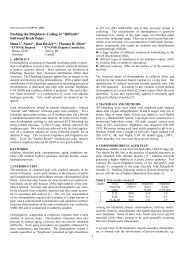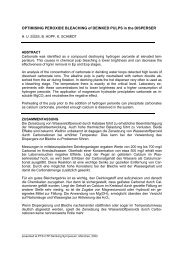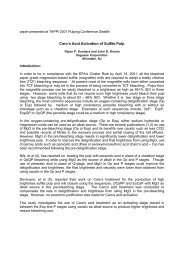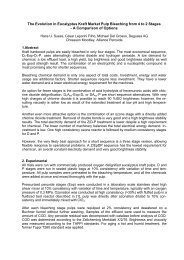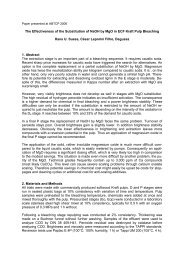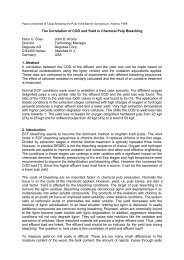How to Improve Brightness Stability of ECF bleached Softwood and ...
How to Improve Brightness Stability of ECF bleached Softwood and ...
How to Improve Brightness Stability of ECF bleached Softwood and ...
You also want an ePaper? Increase the reach of your titles
YUMPU automatically turns print PDFs into web optimized ePapers that Google loves.
Paper presented at 2004 APPITA Conference, Canberra<br />
<strong>How</strong> <strong>to</strong> <strong>Improve</strong> <strong>Brightness</strong> <strong>Stability</strong> <strong>of</strong> <strong>ECF</strong> <strong>bleached</strong><br />
S<strong>of</strong>twood <strong>and</strong> Hardwood Kraft Pulp<br />
HANS ULRICH SUESS, KURT SCHMIDT, BERND HOPF; Degussa AG, Hanau, Germany<br />
1. ABSTRACT<br />
A comparison <strong>of</strong> different <strong>ECF</strong> bleaching sequences regarding the resulting brightness stability<br />
shows an improved stability for brighter pulps <strong>and</strong> no direct influence <strong>of</strong> ozone, hot acid<br />
hydrolysis or hot peroxide stages. The brighter the pulp, the more stable brightness becomes.<br />
This is generally valid for Kraft pulps, provided removal <strong>of</strong> double bonds is effective<br />
<strong>and</strong> the final Kappa number is below 1.<br />
<strong>How</strong>ever, the final bleaching stage <strong>and</strong> the conditions used in this stage do affect brightness<br />
stability. A pulp <strong>bleached</strong> in its final stage with chlorine dioxide (D 2 ) more likely loses brightness<br />
in ageing than pulp <strong>bleached</strong> with a final P stage. Bleaching with chlorine dioxide<br />
leaves quinoid structures in the pulp, with a pronounced tendency for reversion. The oxidation<br />
<strong>of</strong> quinones is easily accomplished with alkaline hydrogen peroxide, therefore brightness<br />
stability is significantly improved with a final P stage.<br />
Very high temperature in a D stage improves the reversion results. Long retention time is<br />
beneficial as well. Reversion is lowest following a hot D 1 <strong>and</strong> a final P stage.<br />
2. MATERIALS <strong>and</strong> METHODS<br />
All trials were made with industrial pulp samples taken after oxygen delignification. D <strong>and</strong> P<br />
stages were run in plastic bags in water baths. Ozone was added <strong>to</strong> well fluffed pulp in a<br />
fluidized bed reac<strong>to</strong>r; Eop stages were conducted in a pressurized high-shear mixer. All trials<br />
(except ozone) were made at 10% consistency. <strong>Brightness</strong> was measured with ISO 2470.<br />
Reversion testing was made with h<strong>and</strong>sheets prepared at pH 6 on a Buchner funnel with a<br />
weight <strong>of</strong> 280 g/m², Tappi methods UM 200 <strong>and</strong> T 260 were used.<br />
3. INTRODUCTION<br />
The target <strong>of</strong> bleaching is a high <strong>and</strong> stable brightness. Unfortunately, in reality pulp brightness<br />
decreases during s<strong>to</strong>rage <strong>and</strong> paper production. It is therefore important <strong>to</strong> keep the<br />
intensity <strong>of</strong> brightness reversion low. Light induced reactions do play only a minor role; these<br />
are limited <strong>to</strong> the pulp bale's surface. In the presence <strong>of</strong> light transition metals <strong>and</strong> oxygen<br />
can cause a chain <strong>of</strong> oxidation processes generating chromophores [1]. <strong>How</strong>ever, these reactions<br />
cannot be <strong>of</strong> importance inside a pulp bale. Therefore this paper will focus on reversion<br />
in the absence <strong>of</strong> light.<br />
Inside a pulp bale reversion is the result <strong>of</strong> chromophores generated by condensation reactions.<br />
This requires available active sites. These can be present as the consequence <strong>of</strong> poor<br />
washing, <strong>and</strong> indeed improving washing with cold or hot water has a positive effect. <strong>How</strong>ever,<br />
washing alone does not solve a reversion problem.<br />
The conditions required for the oxidation <strong>of</strong> lignin can cause an oxidation <strong>of</strong> the cellulose.<br />
<strong>How</strong>ever, the content <strong>of</strong> carbonyl groups in <strong>ECF</strong> <strong>bleached</strong> pulp does not correlate with reversion.<br />
This was the result <strong>of</strong> an analysis with the "CCOA" method [2]. Different <strong>ECF</strong> sequences<br />
had very little variation <strong>of</strong> the carbonyl content but different levels <strong>of</strong> brightness stability.<br />
All results described in this paper are based on <strong>ECF</strong> bleaching. This method represents<br />
more than 90% <strong>of</strong> world's <strong>bleached</strong> pulp production.
2<br />
An analysis <strong>of</strong> brightness reversion requires reasonable testing conditions. Tappi's "UM 200"<br />
describes ageing under moderate conditions, namely a four hours treatment at 105°C in an<br />
oven. This removes water rapidly <strong>and</strong> reversion reactions requiring water will not take place.<br />
Therefore this method produces only moderate differences. Another option is the former<br />
Tappi test T 260, a test over boiling water for 2 hours. This moist method produces data<br />
which correlate better with natural reversion [2].<br />
The different test methods are compared in Figure 1. The pulp <strong>bleached</strong> finally with chlorine<br />
dioxide (D 0 -Eop-D 1 -D 2 ) loses significantly more brightness points compared with the peroxide<br />
<strong>bleached</strong> pulp (D 0 -Eop-D 1 -P). Because the h<strong>and</strong>sheet's pH has an impact, all other tests<br />
were made with a correction <strong>of</strong> the pH <strong>to</strong> 6.<br />
8<br />
7<br />
D: T 260 D: UM 200<br />
P: T 260 P: UM 200<br />
6<br />
losses (points)<br />
5<br />
4<br />
3<br />
2<br />
1<br />
0<br />
5 6 7 8<br />
pH <strong>of</strong> h<strong>and</strong>sheet<br />
Fig. 1: Impact <strong>of</strong> aging conditions on reversion <strong>of</strong> pulp <strong>bleached</strong> with a final D 2 stage or a<br />
final P stage using different h<strong>and</strong>sheet pH <strong>and</strong> reversion conditions; UM 200 at 105°C, dry,<br />
4h; T 260, 100°C, 100% humidity, 2h, over boiling water), brightness ahead <strong>of</strong> testing was<br />
>91 %ISO<br />
__________________________________________________________________________________________________________________________________________________________________<br />
4. COMPARISON <strong>of</strong> SEQUENCES<br />
4.1 "STANDARD" <strong>ECF</strong> BLEACHING<br />
Bleaching removes double bonds. This decreases the ageing potential. <strong>Brightness</strong> reversion<br />
should be higher for a pulp with an incomplete removal <strong>of</strong> "lignin". <strong>How</strong>ever, things are a bit<br />
more complicated. For example, TCF pulps do not have very poor reversion properties despite<br />
<strong>of</strong> a relative high residual <strong>of</strong> double bonds. Thus the kind <strong>of</strong> "double bond" seems <strong>to</strong> be<br />
<strong>of</strong> importance as well.<br />
Table 1: "St<strong>and</strong>ard" conditions in <strong>ECF</strong> bleaching, all at 10% consistency<br />
stage<br />
time<br />
(h)<br />
temperature<br />
(°C)<br />
pH<br />
(begin - end)<br />
D 0 1 50
3<br />
In order <strong>to</strong> generate a "first base" the following assumption was made: Bleaching with moderate<br />
conditions, intense enough <strong>to</strong> remove lignin <strong>and</strong> other double bonds but not <strong>to</strong>o aggressive<br />
<strong>to</strong> harm the cellulose should produce good brightness stability. Table 1 lists the<br />
"st<strong>and</strong>ard" conditions used for this "mild" <strong>ECF</strong> bleaching. The sequence has neither aggressive<br />
bleaching chemicals nor drastic conditions. Radical side reactions should be avoided as<br />
much as possible.<br />
90<br />
88<br />
86<br />
84<br />
82<br />
80<br />
brightness (%ISO) T260 UM200 <strong>bleached</strong><br />
78<br />
1 0,5 P 1,5 0,5 P 2 0,5 P<br />
numbers: D1 + D2 act. Cl in (%)<br />
Fig. 2: Aging <strong>of</strong> pulp with UM 200 <strong>and</strong> T 260 after the stages D 1 or D 2 or P in the sequences<br />
D 0 -Eop-D 1 -D 2 or D 0 -Eop-D 1 -P; D 0 with Kappa fac<strong>to</strong>r 0.23; see Table 1 for other conditions<br />
_________________________________________________________________________<br />
Bleaching with these conditions generates the reversion results <strong>of</strong> Figure 2. Following a D 0<br />
stage with high Kappa fac<strong>to</strong>r (0.23) the use <strong>of</strong> increasing amounts <strong>of</strong> active chlorine in D 1<br />
logically has a positive impact on brightness. These are the observations:<br />
● <strong>Brightness</strong> is high after just three bleaching stages. <strong>How</strong>ever, reversion loss is severe,<br />
especially with the T 260 test.<br />
● Doubling <strong>of</strong> the D 1 active chlorine charge from 1% <strong>to</strong> 2% gives a small brightness gain <strong>of</strong><br />
just 1.1 point. <strong>How</strong>ever, the impact on reversion is positive, losses decrease significantly.<br />
● The application <strong>of</strong> the D 2 stage has an even more positive impact on brightness <strong>and</strong> it's<br />
stability. The same amount <strong>of</strong> active chlorine (e. g. 1.5% <strong>to</strong> D 1 ) split in<strong>to</strong> two portions (e. g.<br />
1+0.5% <strong>to</strong> D 1 +D 2 ) gives more than one additional brightness point.<br />
● Cleaning the pulp by oxidation <strong>and</strong> washing is important for achieving a low reversion.<br />
● Substitution <strong>of</strong> the D 2 stage with a P stage (replacing 0.5% act. chlorine with 0.25% H 2 O 2 )<br />
results in about the same brightness. <strong>How</strong>ever, the peroxide <strong>bleached</strong> pulp is much less<br />
sensitive <strong>to</strong> reversion. Losses decrease significantly. Obviously peroxide more effectively<br />
than chlorine dioxide removes compounds important for reversion.<br />
The post colour number [3] is another useful <strong>to</strong>ol <strong>to</strong> identify differences in reversion. This<br />
method does not compare losses by points <strong>of</strong> brightness, it uses reflectance <strong>and</strong> light scattering.<br />
If expressed as post colour number differences become more visible. In Figure 3 the<br />
T 260 test data <strong>of</strong> Figure 2 are shown as post colour values. The big improvement in stability<br />
with the final P stage is visualised. In combination with the final P stage a very low input <strong>of</strong><br />
chlorine dioxide <strong>to</strong> the D 1 stage is sufficient <strong>to</strong> achieve a very good final stability.
4<br />
2,5 post colour # D1-P<br />
2<br />
D1-D2<br />
D1<br />
1,5<br />
1<br />
0,5<br />
0<br />
1 1,5 2<br />
act Cl in D1 (%)<br />
Fig. 3: Comparison <strong>of</strong> brightness stability after the T 260 test as post color number<br />
brightness (%ISO)<br />
88<br />
86<br />
84<br />
82<br />
T 260<br />
UM 200<br />
<strong>bleached</strong><br />
80<br />
78<br />
D1-D2<br />
D1-P<br />
Fig. 4: <strong>Brightness</strong> stability <strong>of</strong> s<strong>of</strong>twood Kraft pulp; bleaching <strong>of</strong> oxygen delignified pulp with<br />
the sequence D 0 -Eop-D 1 -D 2 or D 0 -Eop-D 1 -P; reversion with T 260 <strong>and</strong> UM 200<br />
_________________________________________________________________________________________________________________________________________________________________<br />
These effects are valid as well for s<strong>of</strong>twood Kraft pulp. Figure 4 shows an identical reversion<br />
pattern for an oxygen delignified pine pulp after D 0 -Eop-D 1 -D 2 or D 0 -Eop-D 1 -P bleaching.<br />
Losses are higher after the D 2 stage <strong>and</strong> lower with a final P stage.<br />
➨ <strong>Brightness</strong> stability improves with higher use <strong>of</strong> more chemical in D 1 . This becomes very<br />
obvious in the post color numbers.<br />
➨ Following D 1 a final P stage generates the better stability compared with a D 2 stage.<br />
4.2 <strong>ECF</strong> BLEACHING with AGRESSIVE STAGES<br />
Modern bleach plants frequently use aggressive process conditions. Hardwood pulp mill operate<br />
their D 0 stage above 90°C. The same temperature level is used in peroxide bleaching.<br />
Some mills apply ozone, a chemical with a very high oxidation potential. These conditions<br />
can cause cellulose oxidation which in turn might trigger more brightness reversion.
5<br />
Figure 5 has the results <strong>of</strong> bleaching with a hot D 0 stage. Two different amounts <strong>of</strong> chlorine<br />
dioxide were applied in the hot D 0 stage. There is no visible impact on final brightness stability.<br />
Losses in reversion do not differ from the results achieved with the "conventional" <strong>ECF</strong><br />
sequence. Again losses are lower for the pulps <strong>bleached</strong> with a final P stage. Similarly the<br />
more aggressive conditions <strong>of</strong> a P(O) stage (95°C instead <strong>of</strong> 80°C in P) do not affect reversion<br />
(Figure 6). The P(O) stage decreases viscosity, however, the lower viscosity has no<br />
impact on aging. On the contrary, the higher input <strong>of</strong> peroxide <strong>to</strong> the P(O) stage moderately<br />
improves brightness stability.<br />
90<br />
88<br />
86<br />
84<br />
brightness (%ISO)<br />
82<br />
80<br />
T 260<br />
UM 200<br />
<strong>bleached</strong><br />
78<br />
D1-D2 D1-P D1-D2 D1-P<br />
D 0<br />
fac<strong>to</strong>r: 0.15 0.23<br />
Fig. 5: Aging <strong>of</strong> eucalyptus Kraft pulp <strong>bleached</strong> with hot D 0 -Eop-D 1 -D 2 or -D 1 -P; active chlorine<br />
in D 1 at 2% with low D 0 fac<strong>to</strong>r <strong>and</strong> 1% at high fac<strong>to</strong>r; final P stage with 0.25% H 2 O 2<br />
brightness (%ISO)<br />
90<br />
88<br />
86<br />
84<br />
82<br />
80<br />
78<br />
T 260<br />
UM 200<br />
<strong>bleached</strong><br />
P P(O) P P(O)<br />
Fig 6: Comparison <strong>of</strong> reversion following moderate or aggressive conditions in final bleaching<br />
with H 2 O 2 ; sequence hotD 0 -Eop-D 1 -P or D 1 -P(O); P with 0.25% H 2 O 2 at 80°C; P(O) with<br />
0.5% H 2 O 2 at 95°C<br />
__________________________________________________________________________________________________________________________________________________________________<br />
Similarly the use <strong>of</strong> lower or higher amounts <strong>of</strong> ozone has no negative impact on reversion.<br />
Figure 7 has the results <strong>of</strong> reversions tests following bleaching with the sequence Zp/E-D-P.<br />
Viscosity <strong>of</strong> these pulps is low. <strong>How</strong>ever, the only obvious effect is a very good stability <strong>of</strong> the<br />
brightness. The high input <strong>of</strong> peroxide in the final P stage has a positive impact. In addition<br />
the old truth is confirmed, the brighter the pulp, the more stable it will be. With a high input <strong>of</strong><br />
bleaching chemical, <strong>of</strong> ozone <strong>and</strong> chlorine dioxide <strong>and</strong> peroxide the resulting brightness is<br />
very high <strong>and</strong> extremely stable.
6<br />
The conclusion is simple. Obviously a high intensity <strong>of</strong> the bleaching process has a positive<br />
impact on stability <strong>and</strong> aggressive conditions do not have a negative impact on reversion.<br />
90<br />
88<br />
86<br />
brightness (%ISO)<br />
84<br />
82<br />
80<br />
T260<br />
UM 200<br />
<strong>bleached</strong><br />
78<br />
O 3 (%): 0.5 0.65 0.65 0.65 0.65<br />
ClO 2 (%): 1.5 1.0 1.0 1.5 1.5<br />
H 2 O 2 (%): 1.5 0.5 1.0 0.5 1.0<br />
Fig. 7: Reversion following bleaching with the sequence Zp/E-D-P; impact <strong>of</strong> different<br />
amounts <strong>of</strong> O 3 , ClO 2 <strong>and</strong> H 2 O 2<br />
__________________________________________________________________________________________________________________________________________________________________<br />
5. REASONS for REVERSION<br />
Hexenuronic acids have a prominent position among the different theories about the causes<br />
for reversion. Tenkanen [4] or Gellerstedt [5] describe hexenuronic acids as the main source<br />
<strong>of</strong> reversion. This is hard <strong>to</strong> underst<strong>and</strong>. As we have seen, reversion <strong>of</strong> <strong>ECF</strong> s<strong>of</strong>twood <strong>and</strong><br />
hardwood pulp seems <strong>to</strong> follow a similar pattern. <strong>How</strong>ever, s<strong>of</strong>twood pulp always has a lower<br />
content <strong>of</strong> hexenuronic acids. Bleaching sequences with hot acid hydrolysis or an ozone<br />
treatment will possibly remove hexenuronic acids <strong>to</strong> a higher extend compared with conventional<br />
sequences. <strong>How</strong>ever, there was no difference visible between the reversion <strong>of</strong> pulp<br />
<strong>bleached</strong> with our "st<strong>and</strong>ard" or with modified <strong>ECF</strong> conditions.<br />
To analyse the potential impact <strong>of</strong> hexenuronic acids a pulp <strong>bleached</strong> with the sequence D 0 -<br />
Eop-D 1 -P ("st<strong>and</strong>ard" conditions, Kappa fac<strong>to</strong>r 0.26 in D 0 ) was in addition treated for 2 hours<br />
at pH
7<br />
Figures 8 <strong>and</strong> 9: Simplified reaction schemes for chlorine dioxide <strong>and</strong> hydrogen peroxide<br />
(perhydroxyl anion) with phenol derivatives <strong>to</strong> oxidation products <strong>and</strong> destruction <strong>of</strong> a quinone<br />
with alkaline peroxide<br />
6 losses (points) 0.5 h 0.5 h 0.5 h 2 h °C<br />
80<br />
5<br />
65<br />
50<br />
4<br />
3<br />
2<br />
0,15 0,3 0,3 + P 0,3 + P<br />
NaOH (%)<br />
Fig. 10: Impact <strong>of</strong> E or Ep conditions on brightness reversion (T 260) <strong>of</strong> an D 0 -Eop-D 1 pretreated<br />
pulp. Pulp brightness after D 1 89.6; P = 0.25% H 2 O 2<br />
__________________________________________________________________________________________________________________________________________________________________<br />
A final peroxide stage needs temperature <strong>and</strong> alkalinity <strong>to</strong> be effective. The reaction with<br />
chromophores or precursors <strong>of</strong> chromophores is rather fast. The conditions required for effective<br />
quinone destruction become visible in Figure 10. The presence <strong>of</strong> peroxide is important,<br />
alkaline conditions only are insufficient. At 80°C the reaction with chromophores or their<br />
precursors needs only 30 minutes <strong>to</strong> reach the optimum. Lower temperature can be compensated<br />
<strong>to</strong> a certain extent with longer retention time.<br />
The importance <strong>of</strong> an alkaline peroxide treatment for quinone removal explains the good<br />
brightness stability <strong>of</strong> TCF <strong>bleached</strong> or <strong>ECF</strong>"light" pulps. These bleaching processes operate<br />
with very intense P stages. The complete degradation <strong>of</strong> all quinoid structures leaves very<br />
little potential <strong>to</strong> form new chromophores in the remaining lignin. It secondly explains why
8<br />
neither Tenkanen nor Gellerstedt could detect quinones as reversion source, their <strong>ECF</strong><br />
"light" or full TCF pulps had had very intense P stages <strong>and</strong> thus a complete elimination <strong>of</strong><br />
these structures. Instead in the reversion test hexenuronic acids, which are completely unaffected<br />
by a peroxide treatment, showed up as remaining culprit.<br />
The results allow an interpretation <strong>of</strong> the effects achieved with a final bleaching stage with<br />
peracetic acid. This chemical is in technical use only in Sweden <strong>and</strong> Finl<strong>and</strong>. It is advertised<br />
as a final brightness booster. Table 2 shows the results <strong>of</strong> a post-treatment simulating a high<br />
density s<strong>to</strong>rage treatment with peracetic acid. High temperature is required <strong>to</strong> increase<br />
brightness, however, this brightness is not very stable. This becomes visible in the post color<br />
numbers.<br />
Table 2: Post-treatment <strong>of</strong> a s<strong>of</strong>twood TCF pulp with 0.5% distilled peracetic acid, simulation<br />
<strong>of</strong> a high density s<strong>to</strong>rage treatment at 10% consistency for 3 h<br />
temp. in Paa<br />
(°C)<br />
brightness<br />
(%ISO)<br />
PC #<br />
initially 86,7 0.632<br />
Paa 50 88,1 0.762<br />
Paa 65 88,5 0.695<br />
Paa 80 88,9 0.650<br />
Paa/P* 80 89,5 0.483<br />
* 0.5 h with Paa, 2.5 h at alkaline pH with H 2 O 2<br />
During its reaction with the remaining lignin peracetic acid hydroxylates phenols. If further<br />
oxidized the resulting hydroquinones will easily form chromophores. Thus a Paa stage gives<br />
a limited improvement. <strong>How</strong>ever, it can be improved easily with an additional alkaline peroxide<br />
step. This degrades hydroquinones <strong>and</strong> quinones. The modification from just a Paa<br />
stage <strong>to</strong> a Paa/P treatment produces an even higher <strong>and</strong> more stable brightness. Peracetic<br />
acid is a good <strong>to</strong>ol <strong>to</strong> activate a P stage. It is not the chemical <strong>of</strong> choice for a better brightness<br />
stability.<br />
6. OPTIONS <strong>to</strong> IMPROVE BRIGHTNESS STABILITY<br />
These data imply the use <strong>of</strong> a final treatment with alkaline hydrogen peroxide as the only<br />
available option <strong>to</strong> improve reversion. <strong>How</strong>ever, before this conclusion is drawn, it is necessary<br />
<strong>to</strong> analyse the potential <strong>to</strong> improve the chlorine dioxide treatment. Conditions generating<br />
less quinoid structures would certainly be favourable. An option is the application <strong>of</strong> more<br />
chlorine dioxide. This intensifies oxidation <strong>and</strong> removal <strong>of</strong> potential chromophores. It is the<br />
simplest way <strong>to</strong> improve results (see Figure 2).<br />
The stabilisation <strong>of</strong> the pH in a D stage has a positive effect. <strong>How</strong>ever, in case higher<br />
amounts <strong>of</strong> chlorine dioxide should be reacted, it is impossible <strong>to</strong> s<strong>to</strong>p the pH from falling.<br />
There are <strong>to</strong>o many acidic compounds generated by the oxidation process. Another approach<br />
could be chemically. Quinones aren't very stable molecules. Provided the temperature<br />
is high enough they will react further, either by decomposition or as strong oxidisers. A<br />
constant charge <strong>of</strong> chlorine dioxide is consumed at higher temperature more completely <strong>and</strong><br />
produces a better D 1 stage brightness <strong>and</strong> reversion. Figure 11 shows the impact <strong>of</strong> the temperature<br />
increase from 60°C <strong>to</strong> 80°C. It is hard <strong>to</strong> imagine that the moderate increase in ClO 2<br />
consumption would be responsible for the improvement. Other reactions, like the oxidation <strong>of</strong><br />
intermediately formed quinones will have <strong>to</strong> contribute. The positive impact <strong>of</strong> these additional<br />
reactions is still visible in brightness <strong>and</strong> reversion improvements after a final P stage.<br />
The post color number decreases with the higher temperature in D 1 from 1.4 <strong>to</strong> 0.9. The P<br />
stage decreases the post color # significantly (Figure 12) further <strong>to</strong> 0.33 <strong>and</strong> with the high D<br />
stage temperature <strong>to</strong> only 0.27.
9<br />
0,2<br />
88<br />
0,1<br />
87<br />
0<br />
0,3 residual (%) 60 70 80<br />
60 70 80<br />
temp (°C)<br />
86<br />
89 brightness (%ISO) 60 70 80<br />
1,5 PC #<br />
1,25<br />
1<br />
0,75<br />
0,5<br />
0,25<br />
temp (°C)<br />
0<br />
temp (°C)<br />
Fig. 11: Impact <strong>of</strong> temperature on chlorine dioxide consumption, brightness <strong>and</strong> post color #<br />
in a in D 1 stage (T 260); s<strong>of</strong>twood Kraft pulp; Eop Kappa 2.2, constant: 1.5% active chlorine,<br />
10% cons., 2h<br />
90<br />
brightness (%ISO)<br />
D1 P PC #<br />
final post color #<br />
0,6<br />
89<br />
0,4<br />
88<br />
0,2<br />
87<br />
60 70 80<br />
temp. in D1 (°C)<br />
Fig. 12: Impact <strong>of</strong> temperature in the D 1 stage on brightness <strong>and</strong> reversion after a final P<br />
stage, reversion test T 260; P stage with 0.25 % H 2 O 2 , 0.3% NaOH, 80°C, 1.5h, 10% cons.<br />
brightness<br />
PC#<br />
post color #<br />
0<br />
0,5<br />
92 brightness (%ISO) 0,2<br />
91<br />
0,4<br />
90<br />
0,3<br />
89<br />
2 4 6<br />
time (h)<br />
Figure 13: Impact <strong>of</strong> retention time in a D 2 stage. S<strong>of</strong>twood Kraft pulp, <strong>bleached</strong> with D 0 -<br />
Eop-D 1 -Ep, D 2 charge constant at 0.5% act. chlorine, 80°C, 10 % cons.
10<br />
The effects become even more pronounced with longer retention time. This was tested in a<br />
five-stage sequence (D 0 -Eop-D 1 -Ep-D 2 ) for the D 2 stage (Figure 13). Because chlorine dioxide<br />
is consumed after about two hours, the impact on brightness is very small. <strong>How</strong>ever, the<br />
longer the pulp is kept at 80°C, the less reversion takes place in aging.<br />
The use <strong>of</strong> very high temperature in chlorine dioxide delignification was first described by<br />
Lachenal [8]. Based on the data <strong>of</strong> Figure 11 it was only consequent <strong>to</strong> apply such conditions<br />
in D 1 <strong>and</strong> D 2 stages. Bleaching a s<strong>of</strong>twood Kraft pulp with the sequence D 0 -Eop-D 1 -E(p)-D 2<br />
at 70°C or 90°C resulted in improved brightness <strong>and</strong> post colour numbers (Figures 14 <strong>and</strong><br />
15). The benefit is very significant for reversion. The advantage <strong>of</strong> H 2 O 2 addition in the extraction<br />
stage between the D stages stays visible not only in a higher brightness but in addition<br />
in a decrease <strong>of</strong> the reversion. Logically, as result <strong>of</strong> new "quinones" formed in the final<br />
D stage the drop is less pronounced compared with a final P stage.<br />
92<br />
70°C<br />
90°C<br />
90°C<br />
90°C<br />
91<br />
90<br />
89<br />
ED2<br />
EpD2<br />
88<br />
87<br />
2+0.5 1.5+0.5 2+0.5 3+0.5<br />
act. Cl, D1+D2 (%)<br />
Fig. 14: Impact <strong>of</strong> hot D stages (D 1 <strong>and</strong> D 2 ) in s<strong>of</strong>twood pulp bleaching with D 1 -E-D 2 or D 1 -<br />
Ep-D 2 ; retention time constant at 4 hours in each D stage, all trials at 10% cons.<br />
0,7<br />
0,6<br />
0,5<br />
0,4<br />
0,3<br />
0,2<br />
0,1<br />
0<br />
post colour #<br />
70°C<br />
90°C<br />
90°C<br />
90°C<br />
2+0.5 1.5+0.5 2+0.5 3+0.5<br />
act. Cl, D1+D2 (%)<br />
Fig. 15: Impact <strong>of</strong> high temperature on post color number (T 260 test)<br />
__________________________________________________________________________________________________________________________________________________________________<br />
The advantage <strong>of</strong> the addition <strong>of</strong> H 2 O 2 in the extraction stage between the D stages is visible<br />
not only in a higher brightness but in addition in a decrease <strong>of</strong> the reversion. Logically, as<br />
result <strong>of</strong> new "quinones" formed in the final D stage the decrease is less pronounced compared<br />
with a final P stage. Nevertheless, the high D stage temperature obviously degrades<br />
compounds in the remaining "lignin" which trigger reversion. This becomes visible in a comparison<br />
<strong>of</strong> the reversion results using the aggressive T 260 test <strong>and</strong> the more moderate UM<br />
200 test. Typically a low temperature (around 70°C) D <strong>bleached</strong> pulp loses more brightness<br />
points in the T 260 test compared <strong>to</strong> the UM 200 test. The high temperature D stage evens<br />
EpD2<br />
ED2<br />
93 brightness (%ISO) D1-<br />
D1-
11<br />
out these differences. High temperature obviously degrades potential chromophores (Figure<br />
16). The hot conditions do not affect the pulp's viscosity. There is a very small increase <strong>of</strong> the<br />
COD, indicating a minor drop in yield by acid hydrolysis, however, the increase is below 2<br />
kg/t, thus at about 0.1% yield.<br />
0<br />
brightness losses (points)<br />
-0,5<br />
-1<br />
-1,5<br />
-2<br />
-2,5<br />
-3<br />
-3,5<br />
70°C<br />
70°C<br />
90°C 90°C<br />
DP DEpD DP DEpD<br />
UM 200<br />
T 260<br />
Fig. 16: <strong>Brightness</strong> losses in reversion after bleaching s<strong>of</strong>twood Kraft pulp with two or three<br />
final stages (-D 1 -P or -D 1 -Ep-D 2 ) at normal or very high temperature in the D stages; constant<br />
2% act. Cl in D 1 , 0.5% in D 2 , P: 0.5% H 2 O 2 , Ep: 0.25% H 2 O 2<br />
1,2<br />
1<br />
0,8<br />
post colour #<br />
temp in D1/D2 (°C)<br />
90/90 75/90<br />
75/75 P<br />
0,6<br />
0,4<br />
0,2<br />
0<br />
P 2 4 6<br />
time in D 2 (h)<br />
Fig. 17: Impact <strong>of</strong> time <strong>and</strong> temperature in D 1 <strong>and</strong> D 2 stages on post color #; bleaching <strong>of</strong><br />
eucalyptus Kraft pulp, sequences D 0 -Eop-D 1 -D 2 or D 0 -Eop-D 1 -P; Eop Kappa 3.6, brightness<br />
81.3 %ISO; D 1 : constant 2% act. Cl, 2h; D 2 : 0.5% act. Cl, time variable, P with 0.25% H 2 O 2<br />
__________________________________________________________________________________________________________________________________________________________________<br />
Additional retention time at very high temperature decreases the post color number further.<br />
Figure 17 shows the impact <strong>of</strong> time <strong>and</strong> temperature for a eucalyptus Kraft pulp. Sequences<br />
were D 0 -Eop-D 1 -D 2 or D 0 -Eop-D 1 -P. The potential chromophores are effectively destroyed by<br />
high temperature in the final D stage. Even at the very high temperature <strong>of</strong> 90°C, an obvious<br />
advantage <strong>of</strong> an extended retention time can be seen. <strong>How</strong>ever, even after six hours at 90°C<br />
in the D 2 stage the post color value remains higher than the value achieved in a final P stage.<br />
This positive effect <strong>of</strong> high temperature in a D stage on brightness stability is nothing new. It<br />
is described in literature. It is not mentioned by Rapson [9] or Reeve [10] in the "recent" descriptions<br />
<strong>of</strong> chlorine dioxide bleaching technology. <strong>How</strong>ever, it is cited by Rydholm [11]. As<br />
early as 1955 Harrison <strong>and</strong> Calkin reported the positive impact <strong>of</strong> very high temperature in a
12<br />
D stage on brightness stability [12]. Apparently they did not publish - as announced - further<br />
work. The obvious difficulty <strong>to</strong> run a D stage in a mill under the conditions described might<br />
have s<strong>to</strong>pped further work. An application <strong>of</strong> a hot chlorine dioxide stage is not easy. There<br />
are practical obstacles. Many chlorine dioxide <strong>to</strong>wers are covered with ceramic tiles <strong>to</strong> prevent<br />
corrosion. The limited stability <strong>of</strong> the adhesives <strong>and</strong> the joints typically restricts the temperature<br />
<strong>of</strong> operation <strong>to</strong> about 80°C. Very long retention time is another problem. In the huge<br />
mills built nowadays the dimensions <strong>of</strong> a <strong>to</strong>wer with several hours retention time would be<br />
extreme.<br />
7. SUMMARY <strong>and</strong> RECOMMENDATIONS<br />
● In <strong>ECF</strong> bleaching no negative impact <strong>of</strong> the bleaching process (chemical <strong>and</strong> temperature)<br />
on brightness stability exists. Quinoid structures seem <strong>to</strong> be the compounds most important<br />
for reversion.<br />
● The elimination <strong>of</strong> these remaining quinoid structures is easily achieved with a final P<br />
stage.<br />
● A final P stage generates a very stable brightness.<br />
● Chlorine dioxide bleaching gives lower brightness stability. Very high temperature in the D<br />
stage can improve results, however, the conditions required are impractical.<br />
Very high brightness <strong>and</strong> good brightness stability will result with these sequences:<br />
● Hardwood pulp: With three stages like Zp/E-D-P or more conventional with four stages<br />
(hot) D 0 -Eop-D 1 -P.<br />
● S<strong>of</strong>twood pulp: Top levels are achieved with four stages (D 0 -Eop-D 1 -P), very high values<br />
are more easily reached with five stages (D 0 -Eop-D 1 -Ep-D 2 ).<br />
8. REFERENCES<br />
[1] K. Fischer; Vergilbung von Hochausbeutezells<strong>to</strong>ff, Papier, 44(10A) V11 (1990)<br />
[2] A. Potthast, J. Röhrling, T. Rosenau, P. Kosma, H. Sixta; Determination <strong>of</strong> carbonyl group<br />
pr<strong>of</strong>iles in cellulosics by fluorescence labeling: Novel application <strong>of</strong> the "CCOA" method, 12 th<br />
ISWPC 2003, proceedings I, 147 - 150 Madison, WI<br />
[3] J.-E. Levlin, L. Söderhjelm, Pulp <strong>and</strong> Paper Testing, p 128-129, ISBN 952-5216-17-9,<br />
Fapet Oy, Helsinki (1999)<br />
[4] M. Tenkanen, I. Forsskåhl, T. Tamminen, M. Ranua, K. Vuorenvirta, K. Poppius-Levlin;<br />
Heat induced brightness reversion <strong>of</strong> <strong>ECF</strong>-light <strong>bleached</strong> pine kraft pulp; 7 th European Workshop<br />
on Lignocellulosics <strong>and</strong> Pulp; Proc. 107 - 110 (2002)<br />
[5] G. Gellerstedt, O. Dahlman, Recent hypothesis for brightness reversion <strong>of</strong> hardwood<br />
pulps; International Colloquium on Eucalyptus Kraft Pulp, Unversidade Federal de Viçosa,<br />
Viçosa, MG, Brasil, Sep. 2003, proceedings<br />
[6] A.-S. Jääskeläinen, A.-M. Saariaho, P. Ma<strong>to</strong>usek, A. Parker, M. Towrie, T. Vuorinen;<br />
Characterization <strong>of</strong> residual lignin structures by UV Raman Spectroscopy <strong>and</strong> the possibilities<br />
<strong>of</strong> Raman spectroscopy in the visible region with Kerr-gated fluorescence rejection; 2003<br />
ISWPC, Madison, WI, proceedings 139 - 142<br />
[7] J. Gierer; The Chemistry <strong>of</strong> Delignification; Holzforschung 36(2) 55 - 64 (1982)<br />
[8] D. Lachenal, C. Chirat; High temperature chlorine dioxide delignification: A breakthrough<br />
in <strong>ECF</strong> bleaching <strong>of</strong> hardwood Kraft pulps; 1998 Tappi Pulping Conf. Proceedings, 601 - 604<br />
[9] W. H. Rapson, G. B. Strumila; Chlorine dioxide bleaching; p 113 f; in: The Bleaching <strong>of</strong><br />
Pulp, ISBN 0-89852-043-6, St<strong>and</strong>ard Press, Atlanta 1979<br />
[10] D. W. Reeve, Chlorine dioxide in bleaching stages, p 379- 394 in: Pulp bleaching: principles<br />
<strong>and</strong> practice; ISBN 0-89852-063-0, Tappi Press, Atlanta 1996<br />
[11] S. Rydholm, Pulping Processes, Interscience Publishers ISBN 0 471 74793 9, p. 983<br />
(1965)<br />
[12] W. D. Harrison, C. R. Calkins; A study <strong>of</strong> variables affecting chlorine dioxide bleaching <strong>of</strong><br />
semi<strong>bleached</strong> sulphate pulp, Tappi J. 38 (11) 641 - 648 (1955)


